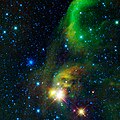Ficheiro:PIA13064.jpg

Dimensões desta antevisão: 600 × 600 píxeis. Outras resoluções: 240 × 240 píxeis | 480 × 480 píxeis | 768 × 768 píxeis | 1 024 × 1 024 píxeis | 2 048 × 2 048 píxeis | 4 095 × 4 095 píxeis.
Imagem numa resolução maior (4 095 × 4 095 píxeis, tamanho: 1,25 MB, tipo MIME: image/jpeg)
Histórico do ficheiro
Clique uma data e hora para ver o ficheiro tal como ele se encontrava nessa altura.
| Data e hora | Miniatura | Dimensões | Utilizador | Comentário | |
|---|---|---|---|---|---|
| atual | 14h52min de 27 de abril de 2010 |  | 4 095 × 4 095 (1,25 MB) | Hive001 | {{Information |Description=Original Caption Released with Image: This colorful image from NASA's WISE (Wide-field Infrared Survey Explorer) is a view of an area of the sky over 12 times the size of the full Moon on the border of the constellations Sagitta |
Utilização local do ficheiro
Utilização global do ficheiro
As seguintes wikis usam este ficheiro:
- cs.wikipedia.org
- en.wikipedia.org
- fr.wikipedia.org
- hu.wikipedia.org
- ja.wikipedia.org


